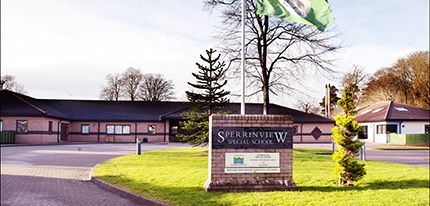Principal's Welcome

Welcome to Sperrinview Special School, “Where Pupils Come First”.
Sperrinview School currently caters for 145 pupils with severe learning difficulties, from 3 to 19 years. The pupils are drawn from South and East Tyrone. Sperrinview is a co-educational, inter-denominational, controlled, day school. We are now located across two sites, the main site in Dungannon, and a second site in Cookstown.
Additionally, we provide support to pupils with a diagnosis of SLD, who have been unable to get placements in Sperrinview Special School. They are based in 4 local Primary Schools, St Patrick's PS Annaghmore, Dungannon PS, St Patrick's PS Dungannon and St Patrick's PS Donaghmore. These classes are called SP EYFS (Special Provision in mainstream Early Years and Foundation Stage classes) .
Located off Fountain Road, Sperrinview’s new Cookstown Annexe is now a provision for our Pre-school, some P1/P2 pupils and 1 older pupil accessing a newly situated Pod.
The building, formerly the Youth Resource Centre, is set in secure grounds with outdoor play and car parking space. There is CCTV around the building which has coded doors for controlled access.
The large foyer leads to two bright and well-equipped nursery classrooms that have flexibility to become one big play area. They lead out to a fully-fenced area with ramped access to a range of outdoor play experiences.
In addition, there is an indoor Soft Play Room, a dedicated Therapy Room, a Meeting/Multi-purpose Room and an Office.
Ms Ruth Walker is the Vice Principal managing the site and she is available in the office most mornings. Miss Paula Jordan is the Principal based in Dungannon, but visiting Cookstown fortnightly and she is assisted by Mr John O'Hare, Vice Principal.
The Education Authority has worked closely with Sperrinview staff to ensure that the facility is of the highest standard, tailored to the needs of the pupils. Consultation with therapy colleagues has taken place throughout the process to equip the new building with resources that will support the developmental needs of our children.
The purpose built school in Dungannon, located less than one mile from the centre of town, was first occupied in September 1996 and officially opened in September 1997. A two-phase extension comprising four new classrooms, a sensory room, a teaching kitchen, bathroom and bedroom and a leisure area, was completed in May 2012. Pupils moved into phase one at the beginning of December 2010 and into phase 2 at the beginning of September 2012. Six additional mobile classrooms have been placed on site. The entire school is well equipped, and has several specialised rooms including one for each of the therapists, ie Speech and Language, Occupational and Physiotherapist. There is also a sensory garden, woodland classroom, tree trail and maths trails as well as upgraded specialised play areas [including a green gym], a sensory intervention room, white room, soft play room and a library.
The Principal, 2 non-teaching Vice Principals, 22.6 full-time equivalent teachers and 59.6 full-time equivalent classroom assistants], combine to plan and implement programmes for pupils.
In addition, the therapists [referred to above] have input, as per recommendations in pupils’ statements of special educational needs. A number of other people including the secretary, caretaker, school meals staff, supervisory assistants, cleaners, bus escorts and drivers also make valuable contributions to school life.
The main school population is divided, on the basis of age, into twenty-three classes. Circumstances have dictated that there are a small number of exceptions to this arrangement.
The Junior section of the school in Dungannon includes pupils from J2, J3, J4, J5, J6, Sunbeam, Sunlight and Rainbow. Middle school consists of Classes Sunshine, MA1, MA2, M1, M2 and M3 and the senior school comprises Classes Starlight, SA1, SA2 and T1. We also have a Nurture Room - Butterfly.
Pupils are given opportunities to explore the wider community through regular environmental visits . Participation in events such as the local festival and feis, visits to theatres and involvement in events organised with/for other schools/colleges, provide opportunities to integrate. Work experience placements and careers education programmes, including visits to local industries, are further examples of community links.
Paula Jordan MBE
Sperrinview Special School, 8 Coalisland Road, Dungannon, Co Tyrone BT71 6FA
Tel: 028 8772 2467 | E-Mail: mjordan389@c2kni.net
 Menu
Menu

